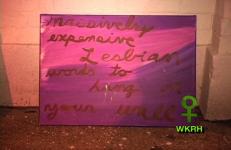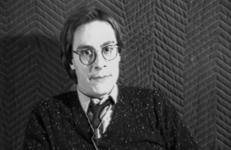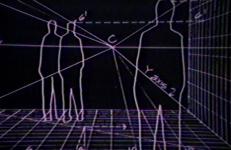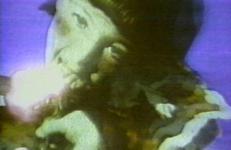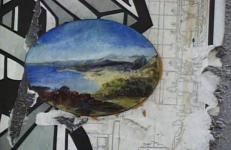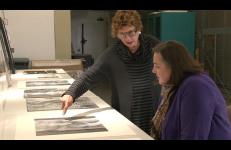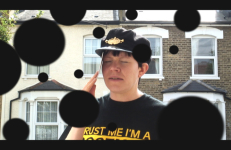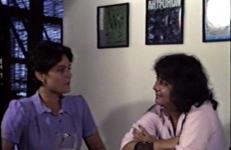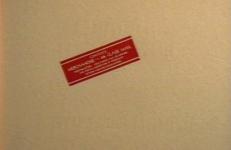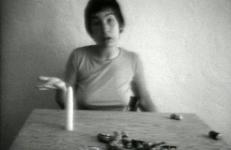Elizabeth Murray (1940-2007) was an American painter, printmaker and draughtsman. She studied at the Art Institute of Chicago (1958–62) and at Mills College, Oakland, CA (1962–4). Elizabeth Murray’s paintings have been referred to as “dandyish abstraction.” Her work is distinctive in its use of color, shape, and surface to evoke human characteristics, personalities or humor. Murray is particularly well known for her shaped canvases, which date from 1976, on to which are painted both figurative and non-figurative elements.
Art Criticism
The second installment of the collaborative project New Report, an ongoing series of performances and videos, Artist Unknown features K8 Hardy (founder of the queer feminist art collective LTTR) and Wynne Greenwood (of Tracy and the Plastics) playing Henry Irigaray and Henry Stein-Acker-Hill, and anchor and roving correspondent for WKRH, a feminist TV news station whose tagline is "pregnant with information." Based on documentation of a live, digital communication in real time between Greenwood at Foxy Production Gallery and Hardy on the street in New York.
The second installment of the collaborative project New Report, an ongoing series of performances and videos, Artist Unknown features K8 Hardy (founder of the queer feminist art collective LTTR) and Wynne Greenwood (of Tracy and the Plastics) playing Henry Irigaray and Henry Stein-Acker-Hill, and anchor and roving correspondent for WKRH, a feminist TV news station whose tagline is "pregnant with information." Based on documentation of a live, digital communication in real time between Greenwood at Foxy Production Gallery and Hardy on the street in New York.
Craig Owens (1950-1990) was a critic who wrote and lectured extensively on contemporary art. He showed particular interest in the issues of photography, postmodernism, feminism, and Marxist thought. A former associate editor for October and senior editor for Art in America, as well as professor of art history at Yale University and Barnard College, his writings were collected in Beyond Recognition: Representation, Power, and Culture (1994). Owens died of an AIDS-related illness in 1990.
The Badger Series has issues and attempts, each episode, to resolve them. Recasting a glove puppet show through his own present day sensibilities, Paul assumes the role of kindly uncle mentor to a household of capersome woodland creatures. Mortality, self-sacrfice, depression, altered states of consciousness and transgressive art practices are all explored as part of their everyday lives together.
The Badger Series has issues and attempts, each episode, to resolve them. Recasting a glove puppet show through his own present day sensibilities, Paul assumes the role of kindly uncle mentor to a household of capersome woodland creatures. Mortality, self-sacrifice, depression, altered states of consciousness and transgressive art practices are all explored as part of their everyday lives together.
This tape examines the meaning, impact, and future of the early-1980s avant-garde through interviews with artists (Scott B., Robert Longo, Walter Robinson, Michael Smith), an art dealer (Helene Winer, Metro Pictures), a museum director (Marcia Tucker, The New Museum of Contemporary Art), and an art historian (Roselee Goldberg). “Whenever you feel confident that you know what’s happening at the outside edge, something’s always happening that you don’t know about. The avant-garde, if it exists at all... is determined by the artist, not the peripheral people like myself,” Tucker says.
Appropriating material from the introduction to the nightly television show, PM Magazine and a commercial for Wang Computers, Birnbaum uses enlarged still-frames from each of the sources to compound a new image of the indelible American Dream. To the soundtrack of an acid rock version of The Doors' L.A. Woman, repetitive images of an ice skater, baton twirler, cheerleader, and young girls licking ice cream, exemplify dominant cultural images of women — images that emphasize their performative nature: the idea that woman is a spectacle arranged for the (male) viewer's pleasure.
Public Discourse is an in-depth study of illegal installation art. The primary focus is on the painting of street signs, advertising manipulation, metal welding, postering and guerrilla art, all performed illegally. Public Discourse is about passionate artists who want their work to be seen by a wide range of people rather than be confined to the systemic structures of galleries and museums.
Public Discourse is an in-depth study of illegal installation art. The primary focus is on the painting of street signs, advertising manipulation, metal welding, postering and guerrilla art, all performed illegally. Public Discourse is about passionate artists who want their work to be seen by a wide range of people rather than be confined to the systemic structures of galleries and museums.
Public Discourse is an in-depth study of illegal installation art. The primary focus is on the painting of street signs, advertising manipulation, metal welding, postering and guerrilla art, all performed illegally. Public Discourse is about passionate artists who want their work to be seen by a wide range of people rather than be confined to the systemic structures of galleries and museums.
Shown at the Brooklyn Museum of Art, Brooklyn. The Real Art World Episodes explore the awkward social interaction of the studio visit. Before a work of art is chosen for exhibition, gallerists or curators visit the artist's studio to meet the artist and see the work in person. Consequently, the artist must convince the visitor of the value of their work. Like a confidence game or a first date, the power dynamics of the studio visit are wrought with miscommunication and ego clashes.
Shown at the Brooklyn Museum of Art, Brooklyn. The Real Art World Episodes explore the awkward social interaction of the studio visit. Before a work of art is chosen for exhibition, gallerists or curators visit the artist's studio to meet the artist and see the work in person. Consequently, the artist must convince the visitor of the value of their work. Like a confidence game or a first date, the power dynamics of the studio visit are wrought with miscommunication and ego clashes.
Shown at the Brooklyn Museum of Art, Brooklyn. The Real Art World Episodes explore the awkward social interaction of the studio visit. Before a work of art is chosen for exhibition, gallerists or curators visit the artist's studio to meet the artist and see the work in person. Consequently, the artist must convince the visitor of the value of their work. Like a confidence game or a first date, the power dynamics of the studio visit are wrought with miscommunication and ego clashes.
Shown at the Brooklyn Museum of Art, Brooklyn. The Real Art World Episodes explore the awkward social interaction of the studio visit. Before a work of art is chosen for exhibition, gallerists or curators visit the artist's studio to meet the artist and see the work in person. Consequently, the artist must convince the visitor of the value of their work. Like a confidence game or a first date, the power dynamics of the studio visit are wrought with miscommunication and ego clashes.
Peter Schjeldahl (b.1942) began writing his “poetical criticism” for Tom Hess at ArtNews in the mid 1960s. He has since written for both popular and specialized publications including The New York Times, Art in America, and The Village Voice, among others. In this interview from 1982, Schjeldahl discusses the critic’s relationship to the artist, the audience, artwork, and the professional community of art critics. He also reads some of his own poetry.Currently, Schjeldahl writes for The New Yorker and various art journals.
Andres Serrano was born and raised in New York. At fifteen he dropped out of high school. A few years later he attended the Brooklyn Museum School and studied painting and sculpture. After two years, Serrano decided that neither of these art forms were appropriate for his particular vision, and began to make photographs. Serrano’s work came to the attention of the general public as part of the controversy surrounding the issue of censorship and the NEA.
The tenth episode in the ongoing Badger series. Themes? Living in the culture of the copy; originality and ownership; inexplicable illness; life on other planets. And wonder, times seven.
Prizewinner at FLEX festival.
Ingrid Sischy was editor of Artforum in the 1980s and has been editor-in-chief of Interview magazine since the 1990s. In this interview with Robin White, Sischy discusses Artforum’s priorities, purpose, and goals.
“It’s an intricate history where painting, sculpture, performance, video, and photography are extremely connected to each other. As the editor of Artforum, I would feel at great fault to not include the best and the most interesting questions of each because they affect each other, and artists’ choices are not made in a vacuum.”
For the past 20 years Alexis Smith's mixed media work has explored primal American myths: the open road, the bad/good guy/gal, the quest for romance, and the search for paradise. This portrait of the artist explores the roots of her thought and work, and was produced in conjunction with her exhibition at the Whitney Museum of American Art, held in November 1991.
Swamp Swamp and Wurmburth are each comprised of a series of tightly cropped shots of small, hand-made table-top sculptures or "sets". Paint and many other materials that behave like paint (i.e. lotion, shampoo, foodstuffs) are blown through these environments with plastic tubing and forced air. Each edited collection of shots makes an endless cycle of primal sludge and rupturing goo.
John Tagg is a writer, educator, and a leading contributor to the development of art-historical and photographic theory, focusing on political analysis of institutionalized culture and interventions within it. He is a professor of art history at State University of New York-Binghamton and author of Grounds of Dispute: Art History, Cultural Politics and the Discursive Field (1992) and The Burden of Representation: Essays on Photographies and Histories (1988). Interview by James Hugunin.
A historical interview originally recorded in 1988.
"I made Take Off in my studio apartment on Myra Avenue during my second year living in Los Angeles. As a member of the Feminist Studio Workshop, I was writing an essay at the time comparing male artists’ representations of their sexuality with female artists’. Vito Acconci was my model for a male perspective. I had been captivated by his videotapes; particularly Undertone, where he was supposed to be masturbating while seated at a table. The videotape was my ultimate response and commentary on Acconci as well as an expression of my own sexuality."
— Susan Mogul





